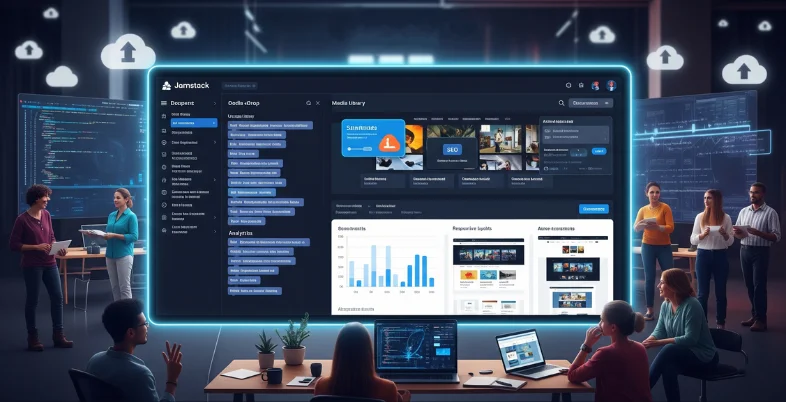What is Jamstack?
Jamstack is a modern web development architecture that emphasizes performance, security, and scalability by decoupling the frontend and backend of a website. The term Jamstack stands for:
-
JavaScript – Handles dynamic functionalities on the client side.
-
APIs – All server-side operations are abstracted into reusable APIs.
-
Markup – Pre-built HTML files served over a CDN.
Instead of relying on a traditional server to render a webpage on every request, Jamstack sites are pre-rendered during build time. These static files are then distributed through Content Delivery Networks (CDNs), resulting in much faster load times and enhanced performance.
Key Benefits of Jamstack
-
Ultra-Fast Performance: Pages are pre-rendered and served via CDNs, dramatically reducing load times.
-
High Security: Eliminating server-side processes minimizes vulnerabilities and attack surfaces.
-
Scalability: Static files can be deployed globally without worrying about backend limitations.
-
Better Developer Experience: Developers can use modern frameworks and tools (React, Vue, Next.js, Astro) while keeping workflows efficient and maintainable.
What is a Headless CMS?
A Headless CMS is a content management system that provides content through APIs without dictating how or where that content is displayed. Unlike traditional CMS platforms (like WordPress or Joomla) that tightly couple the backend and frontend, a headless CMS “loses its head” (presentation layer), allowing developers to fetch content and display it on any platform—website, app, smartwatch, or IoT device.
This separation enables brands to create omnichannel experiences while giving developers complete control over how content is consumed and displayed.
🔧 Popular Headless CMS Platforms
Here are some of the most powerful and widely used headless CMS platforms today:
-
Strapi – Open-source and highly customizable with a developer-first approach.
-
Sanity – Real-time collaboration and structured content with GROQ querying.
-
Contentful – Enterprise-grade CMS with rich APIs and integration support.
-
Hygraph (formerly GraphCMS) – GraphQL-native and excellent for multi-channel content delivery.
-
Payload CMS – JavaScript-based and highly extensible with built-in access control and file management.
Why Combine Jamstack with a Headless CMS?
Combining Jamstack with a Headless CMS results in a powerful decoupled architecture that enhances every aspect of web performance and flexibility. Let’s explore why this combination is reshaping the future of the web:
Performance
With Jamstack, pages are pre-built during the build process and cached on CDNs, which reduces server load and improves Time to First Byte (TTFB). The result? Blazing-fast websites that outperform traditional server-rendered pages.
Security
Because the backend is decoupled and content is served as static files, there’s no direct connection to databases or servers exposed to the public. This reduces the risk of DDoS attacks, SQL injections, and other vulnerabilities.
Flexibility
Developers are free to choose their preferred frontend frameworks—such as Next.js, Nuxt.js, or Astro—and integrate multiple APIs, services, or CMSs as needed. Teams can also swap services without affecting the entire system.
Global Delivery
CDNs replicate content to edge locations worldwide, ensuring users across different regions experience fast load times. This global delivery mechanism is essential for ecommerce, media, and enterprise applications.
Modern Trends in Jamstack + Headless CMS
This architecture is constantly evolving. Here are some of the most impactful trends transforming how developers and marketers use Jamstack and headless CMSs:
AI-Enhanced Content
Modern CMSs now integrate AI capabilities to assist with:
-
Auto-tagging and categorization
-
Generating SEO-friendly content
-
Personalizing content based on user data
-
Summarizing large blocks of text for better UX
Real-Time Collaboration & Previews
Platforms like Sanity and Contentful offer real-time editing, block-based content structures, and visual editors that let marketers see live previews without needing developer intervention.
Omnichannel Content Delivery
A headless approach allows content to be pushed to multiple platforms:
-
Websites
-
Mobile apps
-
Smart devices (voice assistants, kiosks)
-
Internal dashboards or customer portals
This ensures consistency and efficiency in content management.
Edge Functions & Smart Caching
Tools like Netlify Edge Functions or Vercel Middleware now allow logic and personalization to happen at the CDN layer—closer to the user. This means dynamic content, like location-based personalization or authenticated data, can be served without sacrificing speed.
Use Cases: Where Jamstack + Headless CMS Shine
Ecommerce
-
Super-fast product pages
-
Secure and scalable during peak traffic (e.g., sales events)
-
Integration with APIs for inventory, payment, and reviews
Content & Media
-
Optimized for SEO and Core Web Vitals
-
Markdown and rich media support
-
Lightning-fast access to articles and media
Enterprise Websites
-
Complex content workflows with approval systems
-
Multi-region, multi-language content support
-
Better control over content governance and versioning
Apps & SaaS Platforms
-
Unified content source for web and mobile
-
Custom dashboards and documentation sites



